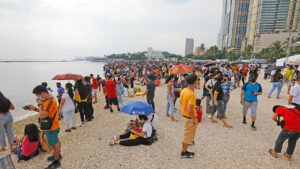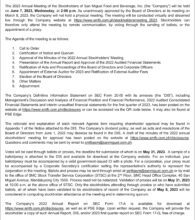Manila could face stricter lockdown if infections rise

THE GOVERNMENT could place Manila, the capital and nearby cities under a stricter lockdown if coronavirus infections continue to go up, health authorities said on Monday, after the Philippines posted 308 cases on June 12.
Stricter quarantine restrictions would only be enforced if a potential surge leads to increased hospital admissions, Health Undersecretary Maria Rosario S. Vergeire said in a statement.
“The possibility would always be there,” she said of the lockdown, even if Filipinos have been learning how to live with the virus. “We know the virus won’t go away, it will stay with us, so these mild and asymptomatic cases, it should be acceptable to the population.”
The Philippines posted 1,682 coronavirus infections on June 6 to 12, 30% higher than a week earlier, according to a Department of Health (DoH) bulletin released on Monday. Five more people died.
Of the total, only 8 or less than 1% were critical, it said.
The agency said 345 or 16.6% of 2,078 intensive care unit (ICU) beds had been used as of June 12, while 3,188 or 20.3% of 15,706 non-ICU beds were occupied.
It added that 498 severe and critical coronavirus patients or 11.3% of total admissions were staying in hospitals.
DoH said 69.76 million people had been fully vaccinated against the coronavirus as of June 12, while 14.53 million people have received booster shots.
The recent increase in coronavirus infections in the Philippines was not yet a cause for concern, said Rontgene M. Solante, an infectious disease expert who has worked with the Philippine government’s pandemic response. He traced the increase to new Omicron subvariants.
“With the report about the entry of the subvariants in the Philippines, we would really expect an uptick of cases,” he told a televised news briefing. “If you look at the 300 plus cases, it’s not something to worry about.”
“So we just have to monitor the cases,” he said. “The most important thing now is to maintain our mask mandate, the health protocols.”
The government should also step up its campaign for booster shots, Mr. Solante said.
Ms. Vergeire said what’s important is that severe and critical cases have not gone up, freeing most local hospitals.
“If cases and hospital admissions go up we will have to shift and escalate the alert level to No. 2,” she said in Filipino.
The capital region has been under Alert Level 1 — the most relaxed in a five-tier system — since March after a drop in daily coronavirus infections.
Last week, Quezon City posted an average of 28 daily infections, forcing the local government to raise the so-called yellow status, according to Rolly Cruz, head of the city’s epidemiology and surveillance unit.
“We may have to calibrate our response and our preparedness here in Quezon City if cases continue to go up,” he told ABS-CBN’s Teleradyo.
The Philippines posted 1,295 coronavirus infections from May 30 to June 5 or an average of 185 daily, which was 1.4% lower than a week earlier, the Department of Health (DoH) said on Sunday.
It earlier detected the more infectious Omicron BA.2.12.1, BA.4 and BA.5 subvariants.
The OCTA Research Group has said the higher positivity rate of 2.2% last week — higher than 1.5% a week earlier — was concerning. This was still within the 5% threshold set by the World Health Organization.
Meanwhile, Trade Secretary Ramon M. Lopez said he doubts that Metro Manila would be placed under a stricter lockdown.
The country needs to sustain its economic recovery, he told reporters in a Viber group message.
“I doubt it,” he said. “We have already learned by now that mild COVID-19 cases and a low intensive care units utilization rates should not lead to escalating the alert level. We need to sustain economic recovery.” — Norman P. Aquino, Kyle Aristophere T. Atienza and R.M.D. Ochave




